Due to the explosion of parasites that happened this winter in my heated coop (as well as the bad luck that came with it), I want to go back to an unheated coop next winter, to keep vermin under control. The only thing I'm not sure about, is if the current coop that I have fits the arrangements I want to make in it. That's where I need your help guys!
(For the sake of helping everyone pinpoint my questions in the text, I've written said questions in bold letters. It would help, however, to read the entire text first, as I have numerous dilemmas and factors that could influence your replies.)
My coop is a 5' x 10-12' ft square space inside a shed. I have the chickens on one side, and the winter/summer items on the other, for short. A door connects the shed to the coop from the north side, and another door leads outside and onto the run from the south. Both doors stand on the 12 ft sides of the coop. The window that gives the most light is angled west, and the place where my 'heated' coop hangs on the east side.
I designed and built the small heated coop last year to keep my chickens warm this winter. It's a tiny, foldable coop cubicle I made inside my main big coop, where I can keep my winter-sensible chickens a bit more heated while the more cold hardy ones stay on the floor, unheated. It's length is 5 ft wide by 3 ft deep, so I can keep 3-4 chickens in there. The heated coop also has two heat lamps; one stays open permanently, the other comes on in extreme cold temperature for additional warmth. My heated coop has multi-purpose uses: quarantine corner, breeding pen, heating coop, sick ward, brooding pen, etc. In the pictures below it's currently used as the quarantine corner.
Front view:
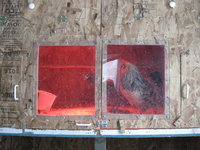
Although they're hard to see, the front is composed of two panels with twin plexiglass windows and four doors in total so I can access all areas of the heated coop. I've got two additional windows for ventilation where the white handles are located at the top of the picture, though in this case I had to leave them closed due to my Ameraucana rooster and its mate carrying lice, among other things.
Interior view (left side, with heat lamp, nest box and hooked feed cup):
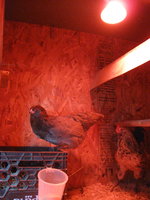
Interior view (right side, with roost perch and metallic roof to give my chickens a chance at sleeping in some shade):
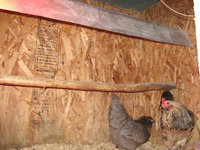
While it can't be seen, the water bowl is closer to the door so I can change it easily.
East side of the big coop, under the heated coop:
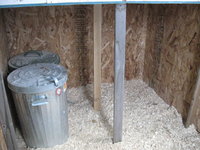
The wooden walls were added last year to give me enough ground to build the heated coop. I plan to divide the space in two this summer where the heated coop supports are currently in use, and use the two separate pens as a brooding pen and flock introduction pen.
North side:
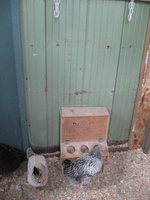
The light green wall is all metal. I plan to cover it with plywood this summer to ease litter cleanse and coop modifications. The previous owner had tacked a pool cover to the floor and bottom sides of the coop with nails, so while the floor was easy to cleanse, the sides where the pool cover exceeded like dress frills are hellish to rid of rip. I built the wooden feeder to stop my hens from wasting food and keep poop/pine shavings from ending in it; it's been very successful so far.
North side(2):
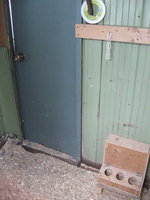
The door that connects the coop to the shed. Snow pile-up pressure on the roof deformed the building this winter, so the door doesn't close all that well, but it sticks firmly enough that the chickens can't get out - and rodents can't get in, either.
West side:
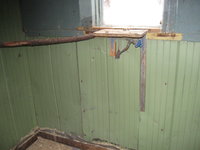
The one window that gives the most sunlight. The upper walls are made of painted plywood; the bottom is all metal. And, of course, the hellish-to-clean pool cover tacking at the bottom, plus a water pipe and a drain in the floor for past sink use. (the last owner had ducks in the shed before switching to chickens. I dragged the sink out for space, but have to watch out for the drain that's hidden in the litter to keep from face-planting whenever I walk around the coop.)
West side (2):
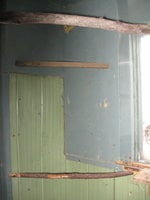
The window again, this time with various roosting perches. The lack of proper walls to work with means I didn't have much options when it came to placing them, so the lowest perch is at the limit of the wall wood zone to give my chickens a chance to reach the higher perch above the window. I placed the perch high above my head so I don't smack my head on it whenever I walk around the coop. Plus I discovered that my chickens were less prone to move away if they're above me, so it's easier to catch them that way.
South side:
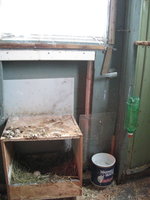
The door that leads to the run outside, with the window I want to keep open next winter at the top. It has chicken hardware so nothing can get in or out, but that was not the case for the chicken coop door that somehow let in a rodent a few months ago. I placed a heavy solid plastic sheet over the chicken door and barricaded the rest of the big door as well as I could with my meager knowledge on construction to keep humidity out and stop cold drafts. The nest ended there to hold the plastic sheet in place, due to lack of walls and proper space in the coop to place it elsewhere; its roof serves as a stepping stone for my bigger hens who need help to get to the middle perch. Unfortunately one of them has a very loose stool, so the nest box also ended up serving as a poop board that I had to clean off everyday. The water container is placed just far enough away from both the nest box and the middle perch that the hens can't poop in it or throw (much) litter in the water. The green bottle is me who later discovered about nipple waterers via youtube and tried it... with no success so far. Snif.
Additional item:
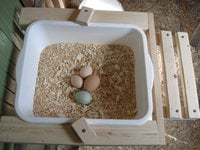
My improved nest box. This happened thanks to my discovering Backyard Chickens in early March 2018 and coming upon all the wonderful ideas that get exchanged here. Having never raised chickens before, I had gleaned what little info I could find from youtube and the internet and what I'd seen from my visits to farmer barns. I had wanted a nest box that was easy to take out and clean yet could be suspended and serve as a stepping stone for my hens without ending up as a poop board, so it is now staying where the middle perch used to be, and is purposely roofless to hamper lice from taking place in it. (I read vermin likes dark corners and shadowed places in wood, so having a roofless and plastic nest box was the best thing I could think of to counter nest box infestation. It does not solve everything, but at least a part of it.) Judging from the eggs I found in it after its first day of use (my Ameraucana hen had managed to escape the heated coop that day, due to one of my locks being out of place), I'd say this new nest box is an eggxellent success. Thank you for all the ideas, BYC!!
Quality-wise, my coop is far from ideal (not angled in the right directions for sunlight, no ventilation, walls are made of metal rather than wood, etc), but it has worked well as far as giving chickens a roof over their heads along with wall insulation. I plan on upgrading the interior of the coop alot this summer so cleaning the litter is not such a hassle in the future, and to give my birds an easier time at getting to their roost bars and nesting boxes.
Now, the things I want to do with my coop are:
1 - leave it unheated for vermin control (mainly coccidiose and lice). The only thing that would be heated is the water container.
2 - leave the south door window open in the hopes it will evacuate stagnant dusty air and supply my chickens with fresh air. There is no ventilation system, though - I'm not a professional builder xP
3 - Only heat the coop in extreme weather temps, hopefully without closing the window. (To give the birds a fighting chance, keep them oxygenated still, and kill any remaining parasites with the sheer cold weather since the only company that sold anti-parasite powder in my spot of the globe has just decided to discontinue the product.)
My understanding of chicken health is that the best immune defense a bird can have against diseases is oxygen, and cold weather prevents parasites and bacterias from taking root in a coop. Both notions are heavily used in open-air coops to promote strong, tough, hardy, healthy birds, which is highly appealing to me since vets are pricey to deal with.
However, this is Quebec I am talking about here. I live in a northern climate that often has temper tantrums, both in hot and cold weather. In wintertime we're easily buried under a meter of snow (sometimes more) and resting at -20°C, with mother nature regularly throwing us -30/-35°C temps, and even -40°C and lower still on extremely cold days. Same thing for summer: 15-25°C temps, with heat waves easily breaching the 30°C zone and going as far as 35/40°C and higher with eolian factor thrown in. The best I can describe our climate, is comparing it to that of the desert: very hot in daytime, and very cold at nighttime. Humidity is a real bummer comfort-wise.
I do not know if the coop I have on hand fits the open-air coop style. Where the entire wall of the west side of the typical open-air coop is left open, I only have an upper door window to go with on the southern side. Plus, I have searched far and wide on the internet for people who may have used this concept in Quebec, and have found none so far. Experience-wise, I have no idea if this style of coop fits my climate, much less my chickens. Have any of you used open-air coops in extremely cold weather (-30/-40°C and lower still), and how did your chickens fare in it? Did you find any faults, flaws, problems with this type of coop in your climate?? How did you fix those flaws?
My next question, linked with the open-air coop and general unheated coop, is how to keep the water unfrozen during winter time at above mentioned temps? I have seen DIY vids about people who used a light bulb inside a cement block or metallic container to keep their waterer unfrozen, others have hand-made their own little heating water tanks, and the list goes on... but no mentions or notes about whether their idea works in extremely cold weathers like the temps I have listed above. I have no temperature numbers to take my cues from, and as I have discovered the hard way, some items American and European people find at their local stores, I can't find anywhere in mine. Also, no comments or notes anywhere as to how much money is spent on electricity bills to keep the water heated during wintertime. Is keeping the water heated less or more costly than keeping an entire coop heated? Pros and cons, guys?
Third question.... How do people who use open-air coops manage to get edible eggs?? I've purposely left the non-edible eggs of my medicated flock (my chickens were on Amphrol against coccidiose) in the shed to see if they would tough out winter cold, and they all froze, splintered and/or cracked open. Is there a trick I don't know about, that allows a chicken owner to get their eggs from an open-air coop safe and sound in the middle of winter? Otherwise having tough, hardy winter-laying birds is a moot point if all the eggs they lay get ruined by the cold before I can come get them.
Lastly... one of my dreams is to get rainbow eggs. I've researched alot of chicken breeds to see if they could fit my climate, and again, have not had much info on how much cold they could take. Save for the Chanteclers, who I know to easily fare against -20°C temps (with claims about also doing fine in -30°C temps, though I'm still looking for proof about those), the rest of my list stands in the mystery zone. So my question is, can the cold-hardy chicken breeds mentioned below fare against -30°C temps and lower still, in unheated coops without risking comb frostbite? And will they keep laying through those temperatures, or stop and restart only in spring??
- Ameraucanas/Legbar family (for blue eggs)
- Welsummers/Barnevelders/Marans (for chocolate eggs)
- Plymouth Rocks/Buckeyes (for mid-brown eggs)
- Wyandottes/Orpingtons/Sussex/Partridge & Buff Chanteclers (for beige eggs - I'm asking about the two Chanteclers because their SOP is very hard to find, so unless I'm mistaken, they have pea combs instead of cushion combs; could the different comb impact their resistance to cold weather?)
- California Greys (for white eggs - said to be extremely cold hardy, but their single combs leave me unsure whether that is true or false.)
- Olive Eggers/Isbars (for green eggs - I understand that Olive Eggers can be made of just about any two chicken breeds, and have been doing research on appropriate parents to give my wanted offspring the best cold resistance and cold-proof comb type.)
Basically, I want to know if my dream & future winter coop plans can match my climate and the chickens I want to put in my backyard, or if I'm getting waaay ahead of my rookie self and should either take the heated coop avenue with crossed fingers that vermin will leave it alone, OR play things safe in my unheated coop by closing the window and use only Chanteclers for guaranteed eggs during wintertime... with hopes to high heavens said eggs won't split open under the cold.
Any input, thoughts, tips and veteran advice would be greatly appreciated to help me figure out this massive puzzle that stands in my backyard. A big THANK YOU goes to anyone that replies in advance!
(I'm sorry if some of the questions listed above do not concern the coop in one way or another; I tried finding the ideal forum for my thread, and this was the place I thought most suitable. I will repost it in another forum thread if asked and pointed to a better place for answers.)
(For the sake of helping everyone pinpoint my questions in the text, I've written said questions in bold letters. It would help, however, to read the entire text first, as I have numerous dilemmas and factors that could influence your replies.)
My coop is a 5' x 10-12' ft square space inside a shed. I have the chickens on one side, and the winter/summer items on the other, for short. A door connects the shed to the coop from the north side, and another door leads outside and onto the run from the south. Both doors stand on the 12 ft sides of the coop. The window that gives the most light is angled west, and the place where my 'heated' coop hangs on the east side.
I designed and built the small heated coop last year to keep my chickens warm this winter. It's a tiny, foldable coop cubicle I made inside my main big coop, where I can keep my winter-sensible chickens a bit more heated while the more cold hardy ones stay on the floor, unheated. It's length is 5 ft wide by 3 ft deep, so I can keep 3-4 chickens in there. The heated coop also has two heat lamps; one stays open permanently, the other comes on in extreme cold temperature for additional warmth. My heated coop has multi-purpose uses: quarantine corner, breeding pen, heating coop, sick ward, brooding pen, etc. In the pictures below it's currently used as the quarantine corner.
Front view:

Although they're hard to see, the front is composed of two panels with twin plexiglass windows and four doors in total so I can access all areas of the heated coop. I've got two additional windows for ventilation where the white handles are located at the top of the picture, though in this case I had to leave them closed due to my Ameraucana rooster and its mate carrying lice, among other things.
Interior view (left side, with heat lamp, nest box and hooked feed cup):

Interior view (right side, with roost perch and metallic roof to give my chickens a chance at sleeping in some shade):

While it can't be seen, the water bowl is closer to the door so I can change it easily.
East side of the big coop, under the heated coop:

The wooden walls were added last year to give me enough ground to build the heated coop. I plan to divide the space in two this summer where the heated coop supports are currently in use, and use the two separate pens as a brooding pen and flock introduction pen.
North side:

The light green wall is all metal. I plan to cover it with plywood this summer to ease litter cleanse and coop modifications. The previous owner had tacked a pool cover to the floor and bottom sides of the coop with nails, so while the floor was easy to cleanse, the sides where the pool cover exceeded like dress frills are hellish to rid of rip. I built the wooden feeder to stop my hens from wasting food and keep poop/pine shavings from ending in it; it's been very successful so far.
North side(2):

The door that connects the coop to the shed. Snow pile-up pressure on the roof deformed the building this winter, so the door doesn't close all that well, but it sticks firmly enough that the chickens can't get out - and rodents can't get in, either.
West side:

The one window that gives the most sunlight. The upper walls are made of painted plywood; the bottom is all metal. And, of course, the hellish-to-clean pool cover tacking at the bottom, plus a water pipe and a drain in the floor for past sink use. (the last owner had ducks in the shed before switching to chickens. I dragged the sink out for space, but have to watch out for the drain that's hidden in the litter to keep from face-planting whenever I walk around the coop.)
West side (2):

The window again, this time with various roosting perches. The lack of proper walls to work with means I didn't have much options when it came to placing them, so the lowest perch is at the limit of the wall wood zone to give my chickens a chance to reach the higher perch above the window. I placed the perch high above my head so I don't smack my head on it whenever I walk around the coop. Plus I discovered that my chickens were less prone to move away if they're above me, so it's easier to catch them that way.
South side:

The door that leads to the run outside, with the window I want to keep open next winter at the top. It has chicken hardware so nothing can get in or out, but that was not the case for the chicken coop door that somehow let in a rodent a few months ago. I placed a heavy solid plastic sheet over the chicken door and barricaded the rest of the big door as well as I could with my meager knowledge on construction to keep humidity out and stop cold drafts. The nest ended there to hold the plastic sheet in place, due to lack of walls and proper space in the coop to place it elsewhere; its roof serves as a stepping stone for my bigger hens who need help to get to the middle perch. Unfortunately one of them has a very loose stool, so the nest box also ended up serving as a poop board that I had to clean off everyday. The water container is placed just far enough away from both the nest box and the middle perch that the hens can't poop in it or throw (much) litter in the water. The green bottle is me who later discovered about nipple waterers via youtube and tried it... with no success so far. Snif.
Additional item:

My improved nest box. This happened thanks to my discovering Backyard Chickens in early March 2018 and coming upon all the wonderful ideas that get exchanged here. Having never raised chickens before, I had gleaned what little info I could find from youtube and the internet and what I'd seen from my visits to farmer barns. I had wanted a nest box that was easy to take out and clean yet could be suspended and serve as a stepping stone for my hens without ending up as a poop board, so it is now staying where the middle perch used to be, and is purposely roofless to hamper lice from taking place in it. (I read vermin likes dark corners and shadowed places in wood, so having a roofless and plastic nest box was the best thing I could think of to counter nest box infestation. It does not solve everything, but at least a part of it.) Judging from the eggs I found in it after its first day of use (my Ameraucana hen had managed to escape the heated coop that day, due to one of my locks being out of place), I'd say this new nest box is an eggxellent success. Thank you for all the ideas, BYC!!
Quality-wise, my coop is far from ideal (not angled in the right directions for sunlight, no ventilation, walls are made of metal rather than wood, etc), but it has worked well as far as giving chickens a roof over their heads along with wall insulation. I plan on upgrading the interior of the coop alot this summer so cleaning the litter is not such a hassle in the future, and to give my birds an easier time at getting to their roost bars and nesting boxes.
Now, the things I want to do with my coop are:
1 - leave it unheated for vermin control (mainly coccidiose and lice). The only thing that would be heated is the water container.
2 - leave the south door window open in the hopes it will evacuate stagnant dusty air and supply my chickens with fresh air. There is no ventilation system, though - I'm not a professional builder xP
3 - Only heat the coop in extreme weather temps, hopefully without closing the window. (To give the birds a fighting chance, keep them oxygenated still, and kill any remaining parasites with the sheer cold weather since the only company that sold anti-parasite powder in my spot of the globe has just decided to discontinue the product.)
My understanding of chicken health is that the best immune defense a bird can have against diseases is oxygen, and cold weather prevents parasites and bacterias from taking root in a coop. Both notions are heavily used in open-air coops to promote strong, tough, hardy, healthy birds, which is highly appealing to me since vets are pricey to deal with.
However, this is Quebec I am talking about here. I live in a northern climate that often has temper tantrums, both in hot and cold weather. In wintertime we're easily buried under a meter of snow (sometimes more) and resting at -20°C, with mother nature regularly throwing us -30/-35°C temps, and even -40°C and lower still on extremely cold days. Same thing for summer: 15-25°C temps, with heat waves easily breaching the 30°C zone and going as far as 35/40°C and higher with eolian factor thrown in. The best I can describe our climate, is comparing it to that of the desert: very hot in daytime, and very cold at nighttime. Humidity is a real bummer comfort-wise.
I do not know if the coop I have on hand fits the open-air coop style. Where the entire wall of the west side of the typical open-air coop is left open, I only have an upper door window to go with on the southern side. Plus, I have searched far and wide on the internet for people who may have used this concept in Quebec, and have found none so far. Experience-wise, I have no idea if this style of coop fits my climate, much less my chickens. Have any of you used open-air coops in extremely cold weather (-30/-40°C and lower still), and how did your chickens fare in it? Did you find any faults, flaws, problems with this type of coop in your climate?? How did you fix those flaws?
My next question, linked with the open-air coop and general unheated coop, is how to keep the water unfrozen during winter time at above mentioned temps? I have seen DIY vids about people who used a light bulb inside a cement block or metallic container to keep their waterer unfrozen, others have hand-made their own little heating water tanks, and the list goes on... but no mentions or notes about whether their idea works in extremely cold weathers like the temps I have listed above. I have no temperature numbers to take my cues from, and as I have discovered the hard way, some items American and European people find at their local stores, I can't find anywhere in mine. Also, no comments or notes anywhere as to how much money is spent on electricity bills to keep the water heated during wintertime. Is keeping the water heated less or more costly than keeping an entire coop heated? Pros and cons, guys?
Third question.... How do people who use open-air coops manage to get edible eggs?? I've purposely left the non-edible eggs of my medicated flock (my chickens were on Amphrol against coccidiose) in the shed to see if they would tough out winter cold, and they all froze, splintered and/or cracked open. Is there a trick I don't know about, that allows a chicken owner to get their eggs from an open-air coop safe and sound in the middle of winter? Otherwise having tough, hardy winter-laying birds is a moot point if all the eggs they lay get ruined by the cold before I can come get them.
Lastly... one of my dreams is to get rainbow eggs. I've researched alot of chicken breeds to see if they could fit my climate, and again, have not had much info on how much cold they could take. Save for the Chanteclers, who I know to easily fare against -20°C temps (with claims about also doing fine in -30°C temps, though I'm still looking for proof about those), the rest of my list stands in the mystery zone. So my question is, can the cold-hardy chicken breeds mentioned below fare against -30°C temps and lower still, in unheated coops without risking comb frostbite? And will they keep laying through those temperatures, or stop and restart only in spring??
- Ameraucanas/Legbar family (for blue eggs)
- Welsummers/Barnevelders/Marans (for chocolate eggs)
- Plymouth Rocks/Buckeyes (for mid-brown eggs)
- Wyandottes/Orpingtons/Sussex/Partridge & Buff Chanteclers (for beige eggs - I'm asking about the two Chanteclers because their SOP is very hard to find, so unless I'm mistaken, they have pea combs instead of cushion combs; could the different comb impact their resistance to cold weather?)
- California Greys (for white eggs - said to be extremely cold hardy, but their single combs leave me unsure whether that is true or false.)
- Olive Eggers/Isbars (for green eggs - I understand that Olive Eggers can be made of just about any two chicken breeds, and have been doing research on appropriate parents to give my wanted offspring the best cold resistance and cold-proof comb type.)
Basically, I want to know if my dream & future winter coop plans can match my climate and the chickens I want to put in my backyard, or if I'm getting waaay ahead of my rookie self and should either take the heated coop avenue with crossed fingers that vermin will leave it alone, OR play things safe in my unheated coop by closing the window and use only Chanteclers for guaranteed eggs during wintertime... with hopes to high heavens said eggs won't split open under the cold.
Any input, thoughts, tips and veteran advice would be greatly appreciated to help me figure out this massive puzzle that stands in my backyard. A big THANK YOU goes to anyone that replies in advance!
(I'm sorry if some of the questions listed above do not concern the coop in one way or another; I tried finding the ideal forum for my thread, and this was the place I thought most suitable. I will repost it in another forum thread if asked and pointed to a better place for answers.)
Last edited:





